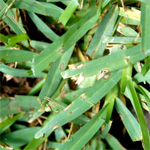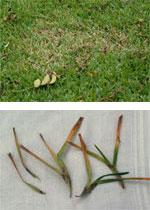Identifying Issues of St. Augustine Lawn Management
I have, in my 30-plus years on the radio, taken some 300,000 phoned-in questions. I have found St. Augustine diagnostic calls to be ultimately frustrating. Symptoms of the various problems are very difficult for home gardeners to describe accurately and in a time frame that can fit into a talk show.
Let me try to differentiate as best I can. I have lived with St. Augustine lawns for almost all of my life. I love the grass, but I, too, find it a little challenging at times. This is a complete list of the issues people have brought to me. Hopefully, you will find your answer here.
Take All patch. Shows up in spring. Areas are not as green as you would wish, even yellow and sometimes browned and dead. When you pull on the runners, they come loose easily from the soil. The roots are shortened and obviously dried and dead. This is the disease that Texas A&M research pathologist Dr. Phil Colbaugh found responds better to an acidic soil surface than it will to a fungicide treatment. Apply one-half inch of any brand of Canadian peat moss to the surface of the lawn. Rake it out smooth and water it lightly several times to filter it onto the soil’s surface. The photos you see in my MAQ section of our website are from my own lawn, and they show the beneficial effects of applying the peat.
.jpg)
.jpg)



Gray leaf spot.
Gray leaf spot. Shows up in mid-summer and early fall (times may overlap with Take All patch). Grass appears yellowed in washes across the lawn. Your temptation will be to apply a high-nitrogen fertilizer to green it back up again, but this accelerates the disease. On close inspection of affected turf, you’ll see b-b-sized, gray-brown, diamond-shaped lesions on the blades and runners. Discontinue nitrogen until early fall, and apply a labeled fungicide.
Excessive shade. Grass thins and dies away. Same symptoms as above two problems, but is directly associated with increased amount of shading. Grass usually does not yellow in this process. Only solutions: remove one or two lower branches to allow more light to reach the turf, or switch to a more shade-tolerant groundcover to replace the failing turf.
St. Augustine decline. This is less common now than in years past since most of our lawns are now planted in resistant varieties. It is not a likely candidate if the turf is less than 30 years old. SAD is a viral disease that causes yellowed areas. Individual blades, on close inspection, are gently mottled in shades of yellow. There is no chemical control for SAD. It will be more evident in spring and fall. Replace with a resistant variety.
Iron deficiency. Yellowed blades, often with dark green veins. This is a comparatively minor problem unless you live in really alkaline soils of the Texas Hill Country. In fact, even completely healthy St. Augustine will occasionally show these symptoms when the grass is fertilized with a fast-release, all-nitrogen fertilizer. It will usually outgrow that issue, but, for more widespread iron chlorosis problems, you may need to apply a sulfur-iron additive. Keep it off concrete and other masonry surfaces that could be stained.
Grub worms. The grass will turn yellow in irregular patches, usually in the fall. When you pull on the grass, it will come loose in your hands since the grubs will have devoured its roots. If you find 4 or more of the almost-one-inch-long larvae with brown heads and legs in the top several inches of the soil, apply a labeled insecticide. The best treatment time is actually mid-summer, as the young larvae are starting to develop.
Chinch bugs. These will make areas of your lawn look dry. You’ll water the turf, but it won’t respond. They will show up in the middle of the summer, and they’ll be in the hottest, sunniest part of your lawn. Old suggestions called for pushing a can with no top or bottom into the soil, then filling the can with water. The chinch bugs would float to the top. If that works for you, great, but most of us have trouble driving it through the runners and into hard Texas soil. It’s easier to get on your hands and knees and part the grass blades at the interface between dying and healthy grass. If you do that on a hot afternoon, you’ll see the b-b-sized, black insects with white, diamond-shaped patches on their backs moving around in the lawn. Use a labeled insecticide. Treat at first evidence. Chinch bugs can kill patches of St. Augustine in short order. They tend to return to the same places each summer.

Brown patch.
Brown patch. This fungal leaf disease hits only during cool weather, usually in the fall, and most commonly in October and November. The grass will yellow in round patches, usually 15 to 24 inches in diameter. Within a week, the patches will have turned yellow and the blades will pull loose very easily from the runners. You will be able to see the decayed bases of the sheaths of the leaves (where they attach to the runners) as proof of the fungus. Treat with a labeled fungicide, and water only in early morning hours so that the grass won’t be wet overnight.
Runners arching over the lawn between mowings. This alarms some gardeners, but it’s almost entirely cosmetic. For some reason, the affected runners don’t "peg down" to the soil. It happens in mid-summer more than at other times, but it does not indicate any kind of special problem. Lift them up with your foot before you mow and you’ll be able to remove them with no ill effects to the lawn.
Nitrogen deficiency. If your St. Augustine isn’t growing as well as it should, and if conditions are favorable otherwise (sunny site, warm weather), it may need to be fertilized. Use a high-quality lawn food with half or more of its nitrogen in slow-release form. Fertilize in late March or early April, early June and early September. Personally, I would never recommend a weed-and-feed fertilizer. The two processes should be handled separately.
